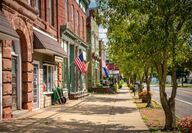Sorted by date Results 1 - 25 of 231

How to care for elderly loved ones at home Taking care of elderly parents at home can be rewarding. Many seniors prefer to age in a familiar place, encouraging adult children to have aging parents live at home instead of residential care facilities. However, caregiving encompasses huge responsibilities. Your loved one’s degree of mobility and independence impacts the type of work to expect. You typically need to assist with their daily activities, offer emotional support and manage medical n...

$5B in OTC dollars go unclaimed by seniors annually Medicare Advantage over-the-counter (OTC) benefits are insurance-provided allowances that enable seniors to buy everyday health and wellness products. They work similarly to FSA accounts and the average person on Medicare Advantage has $400 in OTC credits to purchase items they would otherwise pay for out of their own pocket. These funds are included as an ancillary benefit for many Medicare Advantage plans, yet they frequently go unused becaus...

What questions should you ask a caregiver? Hiring a caregiver is a decision that significantly impacts your elderly loved one and the wider family dynamic. On the one hand, you want someone who is competent and well-qualified. On the other hand, having someone who cares about your senior loved one is also vital. It’s like meeting a potential new family member who will instantly become an important part of your life. A reputable home care company will send you caregivers who have undergone a s...

How changes in Medicare telehealth coverage limit access to key services for neurodivergent patients According to the Centers for Disease Control and Prevention, telehealth use among U.S. office-based doctors shot up during the COVID-19 pandemic, rising from just 15.4% in 2019 to 86.5% by 2021. What started as a crisis response quickly became a lifeline, especially for neurodivergent patients, such as those with ADHD or autism. For them, virtual care helps cut sensory overload, makes it easier...

Aging at home: How families and care teams are meeting the rising demand for in-home support Across the country, older adults and their families share a common goal: the ability to live safely, independently, and confidently at home. The demand for home- and community-based services (HCBS) continues to grow, driven by an aging population and the desire for greater comfort, connection, and autonomy. States, managed care organizations (MCOs), and local agencies are responding with innovative...

Before you buy: 5 key questions about OTC hearing aids For many adults, hearing challenges can make conversations, restaurants, or phone calls more difficult to follow. These difficulties often increase with age, as hearing loss becomes more common over time. According to the National Institute on Deafness and Other Communication Disorders, around 5% of adults ages 45 to 54 experience disabling hearing loss, increasing to 10% among those 55 to 64. The prevalence continues to rise with age,...

Depression in retirement: Why it happens and what to do Retirement is often associated with feelings of joy, relaxation, and freedom, but research shows it can also be a challenging time emotionally. Many individuals who retire struggle with unexpected feelings of sadness, anxiety, or emptiness as they leave behind careers that provide structure, identity, and daily purpose. Recognizing this reality is crucial. LifeStance Health shares how people can proactively address potential emotional...

State of Medicare heading into 2026: Your complete guide to new laws and avoiding surprise bills Prescription drug costs have long been one of the biggest financial burdens for Americans, but relief may be on the horizon for many. Starting in 2026, Medicare will fully implement a $2,000 annual cap on out-of-pocket drug spending. This is a landmark change baked within the Inflation Reduction Act, potentially offering reprieve to millions around the country. However, this new rule comes with certa...

The annuity rebrand: How self-directed investors are shaping the future of retirement income Over the past several decades, society has undergone a notable cultural shift — one marked by the transition from full-service gas stations to self-service pumps. This evolution reflects a broader movement toward autonomy that now permeates daily life, from self-checkout to investing for retirement. Research conducted in January 2025 by financial services company Gainbridge highlights how this shift i...

Coping with the retirement killer: Inflation The next time you’re making retirement calculations, don’t forget one very important factor that can blow up the whole equation. Inflation. If you have a dollar now, that dollar isn’t going to be worth nearly the same in 20 or 30 years, because of a loss of purchasing power. With the cost of almost everything going up every single year, that dollar is constantly eroding in value, even if you keep it safe under a mattress. As an individual, there...

Most Social Security recipients say 2.8% COLA isn’t enough Starting in January 2026, the average monthly Social Security check for the U.S.’s 74.5 million Social Security recipients will be around $1,917, up 2.8% from 2025. That’s an increase of about $52 per month. But the majority of beneficiaries aren’t happy with that increase. According to The Motley Fool’s annual Social Security Cost-of-Living Adjustment (COLA) Survey, 54% of Social Security recipients say the 2.8% cost-of-l...

The Social Security Administration has announced a 2.8% cost-of-living adjustment (COLA) for 2026, increasing monthly benefits for more than 71 million Americans starting in January. The adjustment, based on inflation data from the third quarter of 2025, is intended to help retirees, disabled individuals, and Supplemental Security Income (SSI) recipients keep pace with rising costs. What It Means for Alabama Families For the average retire receiving $2,000 per month, the 2.8% increase...

What are the best in-home care options for seniors with dementia? More family members and seniors are considering in-home care as a superior option to traditional nursing home facilities. In-home care allows your loved one with dementia to spend time in a familiar space surrounded by other family members, allowing them to retain their independence for longer. If you’re considering in-home care for your loved one with dementia, this guide from Village Caregiving will help you make an informed d...

Micro-retirements are on the rise. Here's what HR leaders need to know Why are some high-performing employees walking away from their jobs for weeks or even months at a time—voluntarily? The answer lies in the rise of "micro-retirements," a career break trend especially popular among Gen Z and millennial workers. An estimated 10% of U.S. workers plan to take a micro-retirement this year, according to SideHustles.com. Unlike traditional sabbaticals, which are often employer-sponsored, micro-retir...

How increased lifespans are reshaping retirement security across the US One of the many upsides to living in the 21st century is that average life expectancies are higher than ever before, and so people who make it to retirement age can expect to enjoy many more years of health and happiness than their parents and grandparents. This creates concerns at a state and national level, as the aging population puts pressure on various systems that were designed and implemented long before current...

A small town main street. lucasImages // Shutterstock 50 metros where your Social Security check goes the furthest Retirement evokes excitement as you leave behind the working world and enjoy your days to the fullest. Upon retirement, your monthly Social Security check bolsters other retirement savings to provide a regular income during your golden years. The amount of that monthly check depends on how much you've earned during your working years, regardless of where you've lived. You must work...

The rising cost of waiting: How inflation impacts retirement savings across the US It’s impossible to ignore the gnawing presence of inflation, as it infiltrates almost every aspect of daily life, from the price we pay for groceries to the cost of everything from travel and car maintenance to property and healthcare. While the immediate impact grabs the most headlines, it’s the long-term effects that deserve even more attention, especially from the perspective of retirement savings. Putting cas...

The hidden costs of aging in place and how to afford it The desire to remain in familiar surroundings as you age is natural and personal. For many older adults, aging in place means maintaining independence, cherishing memories and preserving the comfort of home. While this emotional appeal of aging at home is undeniable, the financial reality involves significant costs that often remain hidden until they become urgent necessities. Village Caregiving’s guide will walk you through these o...

How can I encourage my elderly parent to use a medical alert device? If you have an elderly parent, you've probably had some sleepless nights over them living alone. Even if your parent is still active and independent, you worry about them being unable to call for help in an emergency situation. Falls are the leading cause of injury for adults 65 years and older. Medical alert devices quickly connect seniors to emergency services if they fall or need help. They can be life-changing, but many...

Best counties to retire to in Alabama Buyers and sellers of real estate alike—when asked what the three most essential considerations about a property are—will nearly always reply "location, location, location." While this answer is sometimes tongue-in-cheek, it is often quite accurate, and this reply perhaps applies to retirees more than any other demographic. Settling down after a lifetime of working and possibly raising a family calls for the perfect location: a spot where you can enjoy lif...

Cheerful couple walking on pedestrian street. Rido // Shutterstock Best small towns for retirees in every state Many Americans who have bid farewell to the workforce or who are thinking about it are turning to places that offer affordability, a strong economy, quality health care options, less traffic, and overall, more comfort. A 2025 analysis of Census Bureau data by HireAHelper found that more than 258,000 Americans relocated upon retirement in 2024. Just over 32% of those retirees moved...

Can family caregivers get paid through Medicaid? When a relative can no longer shower safely or forgets to take their medications, you may step in to provide care. As a family caregiver, you may assist with bathing, dressing, and eating. These tasks are known as activities of daily living (ADLs). Caregivers may also help with instrumental activities of daily living (IADLs), such as cooking, cleaning, and shopping. About 1 in 4 Americans serves as a family caregiver. That’s about 63 million p...

Social Security Celebrates 90 Years of Service to the American People President Trump signs proclamation recognizing the enduring strength and importance of Social Security Today, the Social Security Administration (SSA) proudly commemorates its 90th anniversary, marking its unwavering commitment to the financial security and dignity of millions of Americans. Since President Franklin D. Roosevelt signed the Social Security Act into law on August 14, 1935, the program has grown into one of the...

What you need to know about arthritis, from causes and management to emerging treatment Arthritis is a complex and often misunderstood condition that affects millions of individuals worldwide. It is not a single disease but rather an umbrella term that encompasses over 100 types of joint disorders. Each type has unique features, but they all share one common symptom: inflammation in one or more joints, which causes pain, stiffness, and decreased range of motion. This comprehensive article from...

How to help an elderly person with dementia Older people living with dementia require ongoing support, understanding, and care. For many family members, caring for their loved one brings many responsibilities. Sometimes, it can be overwhelming. If you’re caring for a relative with dementia, remember that it’s OK to ask for help. This guide from Village Caregiving outlines five simple steps to care for your loved one with dementia. Understanding Dementia Dementia is a medical term used to des...